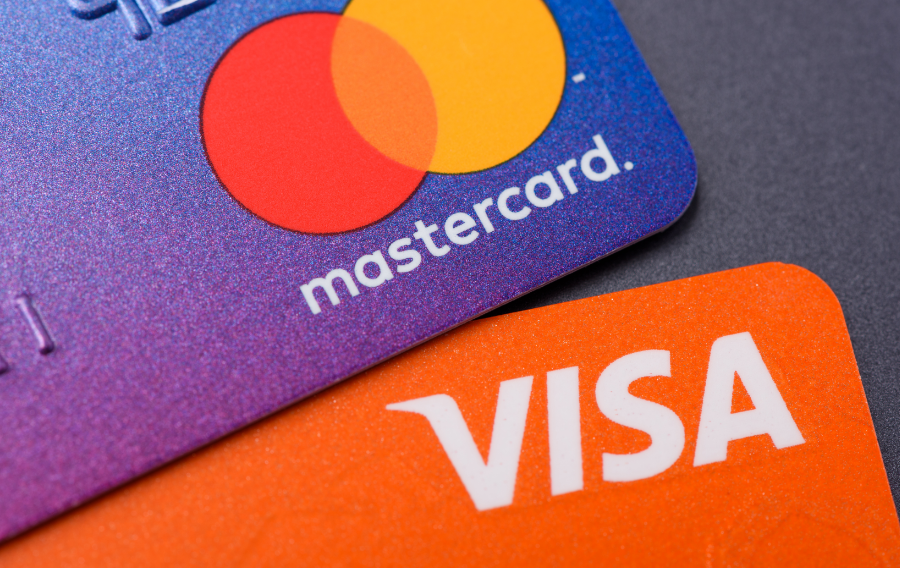Picture yourself at a checkout counter, holding your wallet; most of the time, it’s about us, the customers, trying to decide between using a Visa or Mastercard. This situation is familiar to many shoppers across the world. But what sets these two options apart? As a matter of fact, grasping the differences between these two powerhouses in the payment processing industry can have significant financial advantages for you.
So, let’s take a closer look at the history, operations, and unique offerings of each payment network to help you make an informed decision on which card might be the best fit for you on your spending journey. Join us to discover Visa and Mastercard and take your pick.
Getting to Know Visa and Mastercard
As we all know, Visa and Mastercard are two major players in the financial industry, enabling transactions worldwide. However, unlike banks, they do not provide cards or offer credit directly to consumers. Instead, they work through a wide network of financial institutions that provide branded Visa and Mastercard products.
This comprehensive structure is essential for both in reprising their roles in global transactions. They offer the technology and network required to process payments while leaving direct customer interactions to their partners.
What are the Main Distinctions Between Visa and Mastercard?
Visa and Mastercard provide pretty comparable products, such as credit, debit, and prepaid cards. However, they have notable variations in their operational approach, fee structures, and additional services that might impact your decision:
1. Fees: Visa usually charges fees based on transaction volumes or per transaction, while Mastercard fees are generally calculated as a percentage of the transaction amount.
2. Card Levels: Both networks offer different tiers of cards-Visa has Traditional, Signature, and Infinite;
Mastercard provides Standard, World, and World Elite, each with different benefits and privileges.
3. Technology: Visa utilises payWave technology for contactless payments, while Mastercard utilises PayPass. Both technologies improve the speed and convenience of transactions, but they are implemented in different ways on their respective networks.
4. Widespread Acceptance: Both networks are widely accepted across the globe, with Visa having a slightly higher acceptance rate. This is mainly because Visa handles a larger number of transactions and has a more extensive network.
A Detailed Look at Visa
Visa’s story started in the 1950s when Bank of America introduced the first consumer credit card. Today, Visa’s vast network handles billions of transactions every year. In 2020, Visa’s operations involved a payment volume of around $8.8 trillion. The company classifies its earnings into different categories, such as service, data processing, international transactions, and others, to showcase its diverse sources of revenue.
Visa provides a wide range of services beyond transaction processing. The network also offers a range of card-related services and benefits, such as fraud protection, travel insurance, and emergency services, which vary depending on the card level.
Discovering Mastercard
Mastercard was established in the 1960s by a group of banks with the aim of challenging Visa’s dominance. It has experienced substantial growth and is widely acknowledged for its strong global presence in 210 countries. Similar to Visa, Mastercard handles a wide range of payment transactions and reported a total payment volume of $6.3 trillion in 2020.
Mastercard sets itself apart by using a unique fee structure that takes into account the global dollar volume. This approach can impact the rates that banks offer to their customers. Mastercard’s card levels provide a variety of benefits, ranging from essential security features on the Standard cards to high-end travel and exclusive services on the World Elite tier.
Visa and Mastercard: Comparative Insights
Visa and Mastercard offer essential services that simplify modern finance. However, their rivalry stems from their approaches to handling relationships with banks, merchants, and card issuers. This competition fosters innovation in various areas, such as improved security features, customer loyalty programmes, and a wide range of financial products designed to meet the needs of different consumers.
Security and technological advancements have become increasingly intertwined in recent years. As technology continues to advance at a rapid pace, the need for robust security measures has become more crucial than ever.
With the rise of cyber threats and data breaches, organisations are constantly seeking ways to enhance their security protocols. From biometric authentication to advanced encryption algorithms, the field of security has evolved to keep up with the ever-changing technology.
Both networks prioritise security, which is especially important given the increasing number of digital transactions.
Visa’s “Verified by Visa” and Mastercard’s “SecureCode” programmes enhance the security of online purchases by adding an extra layer of authentication to minimise the risk of fraud.
In addition, their technologies facilitate contactless transactions that align with the growing trend of tap-and-go payments, showcasing their ability to adapt to consumer preferences and technological advancements.
Deciding Between Visa and Mastercard
When deciding between Visa and Mastercard, it’s important to consider the various offers provided by your bank or financial institution. These offers could include cashback rewards, points, or travel benefits. Functionality and acceptance will likely be similar for most consumers. However, for individuals who travel often or conduct a high number of transactions, the differences in service levels and international fees can have a notable impact.
Regardless of whether you choose Visa or Mastercard, both networks provide reliable solutions that are designed to make global transactions simple, secure, and efficient at every step of the way. Their technologies and services have a profound impact on daily financial activities, even though they operate behind the scenes.
When choosing your next credit or debit card, it’s important to not only look at the terms provided by the card issuer but also consider the benefits offered by each network. This will help you find the card that best suits your financial lifestyle.



